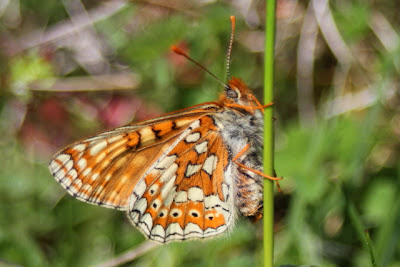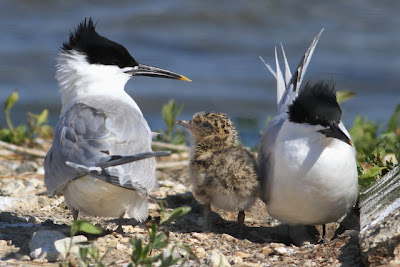My hayfever eyes are back for the summer and judging by a visit on Friday night, it seems that the grass pollen on my local patch at Swineham is just about the worst thing to set them off. A good excuse, then, to neglect it for the rest of the weekend and tart around the country after rarities instead.
 |
| Pacific Swift, Trimley Marshes, Suffolk: note the white rump and deeply forked tail |
About this time last year I floated a hypothesis that
twitching Rollers in Yorkshire was a
bona fide medical treatment for sore eyes: I can now confirm that twitching Pacific Swifts in Suffolk is just as effective.
 |
| Difficult to see in the field, the scaly underparts can be seen here |
News of this mega-rarity broke mid-morning and I exchanged texts with the get-away driver on several recent smash and grabs, Steve Smith. On reflection, these exploratory messages reflected some doubt on both our parts about the wisdom of going for this bird, but the exchange soon morphed into a positive decision to go for it and we were on the road before noon.
 |
| The rump made this bird stand out from the crowd of Common Swift when they approached at speed |
We definitely set out more in hope than expectation: swift-twitching is high risk stuff, as these birds can fly at nearly 70 mph and within the four hours it would take us to get to Suffolk it could have made it to Holland. Swifts can also be pushed on by weather fronts, and the forecast suggested that a mothering rainstorm would hit Felixstowe at about the same time as us.
 |
| This shot shows how far the neat white rump patch extends around the body |
As if these bad omens weren't enough, news came through that police had closed the access road to the site and were ticketing badly parked cars. Being law-abiding folk, with the help of some good local gen obtained via some frantic phone calls
en route, we parked further up the coast at Levington Marina and walked south-east down the sea wall to the site. As we were locking the car the first negative news all day came through: no sign of the bird for the last half hour.
 |
| The bird was feeding over a lagoon in front of the hides at Trimley |
For once, the forecast was spot on and the first peal of thunder echoed around just as we reached the exposed seawall, carrying our Manfrotto
tripods lightning conductors on our shoulders. I'm taller than Steve so felt particularly vulnerable, though was reassured when a line of 100 or so twitchers came into view a couple of miles to the south-east: some of them had to be taller than me so surely they would be struck first? Plus, what with God being just and all, they had already seen Pacific Swift so could die happy.
 |
| The tail shown as the bird banks |
On the long and brisk walk we were getting thoroughly wet, but it could have been worse had we followed my out-of-date OS map rather than our noses, as this did not take account of a recent breach in the seawall, punched through as part of a coastal realignment project. I don't mind an undignified trot to see a bird, but I draw the line at swimming.
 |
| A white chin patch can be seen in this shot |
With a mile to go, the pager reported that the bird was back, but as we arrived at the end of the line the news, like the weather, worsened again: we had missed it by a minute. We took shelter in the hide, where it was standing room only until a couple of slightly less drowned rats who had already seen the swift decided to give up their seats and head back out into the rain.
 |
| The Pacific Swift looked a slimmer bird than this Common Swift |
I was initially keen to stay on the seawall until I had seen the bird but Steve's wiser counsel prevailed: once in the hide, after 10 minutes of panicky de-fogging of optics, during which the Swift was good enough to
not re-appear, we enjoyed a close fly past when it did eventually return. 10 minutes after that and we could hardly see the pool over which it was feeding as the raindrops turned into stair-rods.
 |
| Swifts were not the only birds at Trimley - Avocet and this Red-legged Partridge were also there |
As the evening progressed the weather improved and we were treated to excellent views in good light as the Swift hawked insects over the lagoon. A great bird, a good gamble and nice to have no doubts about hybrids, dubious origins or anything else to doubt the authenticity of the record.
 |
| Do your worst, Trimley weather: I've got a seat in the hide |

+Broomscroft,+Kent.JPG)
+Broomscroft,+Kent.JPG)































































